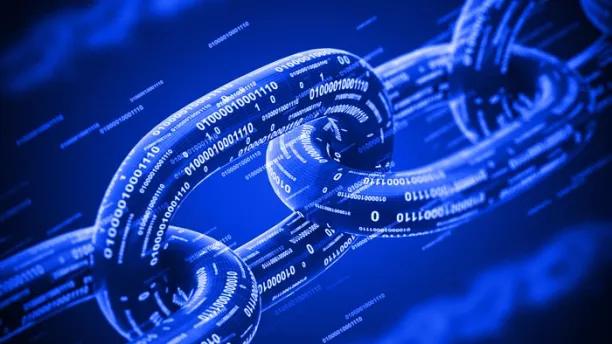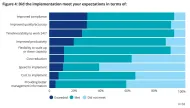4 Benefits, 15 Use Cases of RPA and Blockchain Integration in '24
Robotic process automation (RPA) and blockchain are emerging technologies whose integration can revolutionize companies’ operational efficiency. The good news is that companies are using these technologies more:
- 78% of RPA adopters are expected to invest more in RPA
- Global expenditure on blockchain technologies will be $19B by 2024
Using RPA and blockchain together can can improve key success metrics such as:
- Employee output
- Customer satisfaction
- Data security and privacy
- Cost savings
In this article, we will explain the benefits of using RPA and blockchain exhaustively, 15 specific use cases across industry sectors, and showcase some successful real-life case studies.
Overview of RPA and blockchain technology
Robotic process automation (RPA)
RPA bots work in attended, unattended, and hybrid modes for to automate processes. Robotic process automation (RPA) has +100 use cases and +20 benefits.
RPA bots are always available, scalable, and can be augmented with artificial intelligence tools, also known as intelligent automation. These turn them into efficient digital workers that can reduce employees’ workload and improve customer satisfaction.
Download our RPA whitepaper to learn more about the topic:
Blockchain
Blockchain is an independent technology from RPA. It’s a decentralized ledger used to record data on multiple computers securely and transparently. The data is saved on a “block,” which is attached to another block. All these form a chain – blockchain – and enable blockchain to be a decentralized ledger. Blockchain ensures data immutability and thus transparent records management across various industries, such as finance, supply chain, and healthcare.
How can RPA and blockchain work together?
RPA and blockchain complement each other to fuel digital transformation initiatives. RPA and blockchain can work together by robotic process automation bots automating business processes, and blockchain storing the output data on the chain.

The automated rat-a-tat of process execution and data storage ensures easy data access, data accuracy, and data security.
What are the benefits of using RPA and blockchain together?
The general benefits of using RPA and blockchain technology include:
1. Efficient process execution & easy data access
Robotic process automation automates repetitive tasks that do not require human intelligence. This allows employees to focus on higher-level responsibilities. Blockchain, afterwards, provides a secure ledger for storing the output data.
Combining RPA and blockchain, therefore, streamlines internal and external data exchange. The resultant easy data access can then expedite process/transaction execution.
2. Automated trusted data processing
The average cost of a data breach is $4.35M. RPA and blockchain enable automated trusted data processing. That’s because you can script the bot to record business transactions and store it on the blockchain automatically. And thanks to blockchain’s secured cryptography, data breaches can be minimized.
Learn more about how RPA can enhance cybersecurity.
3. Enhanced transparency
Blockchain provides a transparent, tamper-proof record of business transactions. A use case is smart contracts where both parties can monitor the SLA agreements before the contract is activated.
The transparency also improves audits, as companies can have RPA bots create event log data of modifications done to documents and data sets. Companies can improve their audits by having RPA create event log data of changes done to documents and data sets. This unified framework for records management enhances transparency and improves legal ownership management of content.
4. Regulatory and compliance management
RPA and blockchain technology allow companies to standardize and automate their compliance management. Especially if the company is in an industry with strict compliance requirements, such as the financial industry or the pharmaceutical sector, they can automate repetitive compliance tasks to avoid penalization.
Learn more about RPA in compliance.
Top 14 use cases of RPA and blockchain in different industries
Finance
1. Payments processing: RPA automates payment processing tasks, like data entry and reconciliation. Blockchain can then securely and transparently store payables data. Especially for automated transactions, RPA and blockchain can streamline payments.
2. Anti-money laundering (AML) & know your customer (KYC) processes: RPA can partially automate AML and KYC processes, such as data verification, identity management, transaction flagging, and more. The data can then be secured on the blockchain’s decentralized ledger.
3. Trade finance: RPA can automate data entry on letters of credit and bank guarantee, B2B contracts, SLA monitoring, and more. These data can be stored on the blockchain with timestamps as to when they were created and honored by both parties.
Case study:
Marco Polo Network allows importers and exporters to connect their SLA agreements with ERP systems on the blockchain. So payments are released as soon as delivery receipt is confirmed.
Learn more about trade finance automation.
4. Asset management: RPA can be used for automating tasks related to asset tracking and performance monitoring. Then each asset’s corresponding data, ownership claims, and contracts can be stored on the blockchain.
Learn more about asset management automation.
5. Fraud detection: Smart contracts can be drawn up by RPA bots and stored on blockchain space. This reduces the possibility of unauthorized access and tampering.
Supply chain
6. Improved traceability: Data related to supply chain transactions, delivery timelines, inventory management, invoices, etc. can be recorded by robotic process automation bots and stored on the blockchain space.
7. Reduced fraud and counterfeiting: The tamper-proof and transparent nature of blockchain technology makes it harder for fraudsters to introduce fake products into the supply chain, improving the overall security of the supply chain. Whenever a new item is added, RPA bots will flag it.
Case study:
Nestle and Techrock developed a public blockchain that allows parents to scan a code and automatically see their infants’ baby formula ingredient list.
Healthcare
8. Medical data management: Blockchain and RPA can be used to securely store and manage patients’ medical histories, test results, clinical trials data, and other medical data from different sources and enter it into a blockchain-based medical record system.
9. Claims management: RPA can automate insurance claims processing, while blockchain can be used to securely store and share claims data. Having bot make automated decisions on claims and storing the verdicts on blockchain as a centralized entity increases the transparency of the claims process.
10. Supply chain management: Blockchain can be used to track the movement of drugs and medical devices throughout the supply chain, while RPA automates inventory management and order processing tasks. This improves transparency, prevents counterfeit products entering the market, and enables hospitals and pharmacies to place their reorders on-time.
11. Patient consent management: RPA can automated patients’ consent data and store it on the blockchain. A transparent, secured record showing that each patient has been disclosed on their treatment options and have chosen by their will ensures the hospital’s strong position in all the regulatory events.
Learn more about RPA in insurance.
Insurance
12. Policy management:
RPA and blockchain can automate processes, such as policy issuance to claims settlement, for maximum productivity of the insurance reps. For example, RPA can automatically trigger insurance claims processing based on predefined rules and data.
Blockchain can then securely store and share data between insurers, customers, and other stakeholders. This can lead to faster, more accurate, and more transparent claims processing, ultimately improving customer satisfaction and reducing costs for insurers.
Learn more about RPA in insurance.
Case study:
Etherisc creates smart contracts that pay out victims as soon as insurance conditions are met. The validation happens automatically and on the blockchain, as the RPA bots transfer data between the IoT devices
Customer service
13. Storing customer data: All industries deal with customer data. RPA and blockchain can securely store customer data, such as their personal info, complaints history, past orders, etc.
14. Loyalty programs: Blockchain-RPA integration can be used to manage loyalty programs where in RPA bots would collect and store the data for a secured legal ownership management.
15. Faster dispute resolution: RPA can be used to automate the process of handling customer disputes, while blockchain can provide a transparent and immutable record of the dispute and its resolution.
Explore RPA in customer service in more detail.
Investing in RPA
If you’d like to invest in RPA, we have a data-driven list of RPA vendors.
We can help you through the journey selection process:

Cem has been the principal analyst at AIMultiple since 2017. AIMultiple informs hundreds of thousands of businesses (as per similarWeb) including 60% of Fortune 500 every month.
Cem's work has been cited by leading global publications including Business Insider, Forbes, Washington Post, global firms like Deloitte, HPE, NGOs like World Economic Forum and supranational organizations like European Commission. You can see more reputable companies and media that referenced AIMultiple.
Throughout his career, Cem served as a tech consultant, tech buyer and tech entrepreneur. He advised businesses on their enterprise software, automation, cloud, AI / ML and other technology related decisions at McKinsey & Company and Altman Solon for more than a decade. He also published a McKinsey report on digitalization.
He led technology strategy and procurement of a telco while reporting to the CEO. He has also led commercial growth of deep tech company Hypatos that reached a 7 digit annual recurring revenue and a 9 digit valuation from 0 within 2 years. Cem's work in Hypatos was covered by leading technology publications like TechCrunch and Business Insider.
Cem regularly speaks at international technology conferences. He graduated from Bogazici University as a computer engineer and holds an MBA from Columbia Business School.
To stay up-to-date on B2B tech & accelerate your enterprise:
Follow on

Comments
Your email address will not be published. All fields are required.